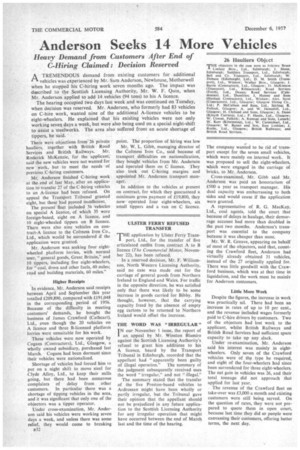Anderson Seeks 14 More Vehicles
Page 38

If you've noticed an error in this article please click here to report it so we can fix it.
Heavy Demand from Customers After End of C-Hiring Claimed : Decision Reserved
A TREMENDOUS demand from existing customers for additional r-k vehicles was experienced by Mr. Sam Anderson, Newhouse, Motherwell when he stopped his C-hiring work seven months ago. The impact was described to the Scottish Licensing Authority, Mr. W. F. Quin, when Mr. Anderson applied to add 14 vehicles (94 tons) to his A licence.
The hearing occupied two days last week and was continued on Tuesday, when decision was reserved. Mr. Anderson, who formerly had 83 vehicles on C-hire work, wanted nine of the additional A-licence vehicles to be eight-wheelers. He explained that his existing vehicles were not only working seven days a week, but were also being used on a special night-shift to assist a steelworks. The area also suffered from an acute shortage of tippers, be said.
There were objections from'26 private hauliers, together with British Road Services and British Railways. Mr. Roderick McKenzie, for the applicant, said the new vehicles were not wanted for new work, but to meet the needs of previous C-hiring customers.
Mr. Anderson finished C-hiring work at the:end of last May, after an application to transfer 27 of the C-hiring vehicles to an A-licence had been refused. On appeal the Transport Tribunal granted eight, but these had proved insUfficient. The present fleet included 56 vehicles on special A licence, of which 35 were foreign-based, eight on A licence, and 10 eight-wheeled tippers on B licence. There were also nine vehicles on contract-A licence to the Coltness Iron Co., Ltd., which would be surrendered if the application were granted.
Mr. Anderson was seeking four eightwheeled platform lorries, with normal user, "general goods, Great Britain," and 10 tippers, including five eight-wheelers, for "coal, dross and other fuels, 40 miles; road and building materials, 60 miles."
Higher Receipts In evidence, Mr. Anderson said receipts between April and September this year totalled £209,890, compared with £191,048 in the corresponding period of 1956. Because of the difficulty in meeting customers' demands, he bought the business of James Crawford (Cathcart), Ltd., even though the 20 vehicles on A licence and three B-licensed platform lorries were unsuitable for his work.
These vehicles were now operated by Cogans (Contractors), Ltd., Glasgow, a wholly owned subsidiary, purchased last March. Cogans had been dormant since their vehicles were nationalized.
Shortage of vehicles had forced him to put on a night shift to move steel for Clyde Alloy, Ltd., to keep their mills going, but there had been numerous complaints of delay from other customers. In particular there was a shortage of tipping vehicles in the area, and it was significant that only one of the objectors was a tipper operator.
Under cross-examination, Mr. Anderson said his vehicles were working seven days a week, and unless there was some relief, they would come to breaking B32 point. The proportion of hiring was low Mr. W. L. Gil:it', managing director of the Coltness Iron Co., said because of transport difficulties on nationalization, they bought vehicles from Mr. Anderson and operated them on C licence. They also took out C-hiring margins and appointed Mr. Anderson transport manager.
In addition to the vehicles at present on contract, for which they guaranteed a minimum gross payment of £19,800, they now operated four eight-wheelers, six small tippers and a van on C licence.
The company wanted to be rid of transport except for the seven small vehicles, which were mainly on internal work. It was proposed to sell the eight-wheelers, which were engaged in the carriage of bricks, to Mr. Anderson.
Cross-examined, Mr. Gibb said Mr. Anderson was paid an honorarium of £500 a year as transport manager. His dual capacity was embarrassing to both sides and would cease if the application were granted.
A representative of R. G. MacKay. Ltd., coal agents, told the court that because of delays in haulage, their demurrage account had more than doubled in the past two months. Anderson's transport was essential to the company because it was cheaper than most.
Mr. W. R. Greave, appearing on behalf of most of the objectors, said that, count
ing the Crawford fleet, Anderson had virtually already obtained 31 vehicles, instead of the 27 originally applied for.
There was little goodwill with the Crawford business, which was at that time in liquidation, and the work must be mainly for Anderson customers.
Little More Work
Despite the figures, the increase in work
was practically nil. There had been an increase in rates of up to 10 per cent., and the revenue included wages formerly paid to C-hire drivers by customers. Two of the objectors had lost work to the applicant, whilst British Railways and British Road Services had sufficient spare capacity to take up any slack.
Under re-examination, Mr. Anderson said his interest was mainly in eightwheelers. Only seven of the Crawford vehicles were of the type he required, and eight of the four-wheelers had since been surrendered for three eight-wheelers. The net gain in vehicles was 26, and their total tonnage did not approach that applied for last year.
The revenue of the Crawford fleet on take-over was £3,000 a month and existing customers were still being served. On the question of rates, they were not prepared to quote them in open court, because last time they did so people were canvassing their customers, offering better terms, the next day.
























































































































